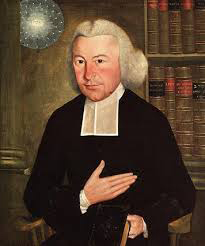Founders of the Connecticut Academy of Arts & Sciences: Five-Minute Profiles
 Ezra Stiles 1727-1795
Ezra Stiles 1727-1795
Presented by Ernest I. Kohorn, MChir, FRCS.
Ezra Stiles was born in 1727 in North Haven, Connecticut, the son of the Rev. Isaac Stiles. He graduated from Yale College in 1746. He studied theology and was ordained in 1749. He tutored at Yale from that year until 1755. He resigned from the ministry in 1753 to study law and practiced in New Haven, but returned to the cloth two years later.
He was asked to be Pastor to Trinity Church, the Anglican Church, in Newport, Rhode Island. Instead, in 1755, he became pastor of the Second Congregational Church in Newport, Rhode Island. While in Newport, he also served as Librarian of the Redwood Library and Athenaeum and kept an informative diary of his life and distinguished acquaintances in Newport, including his association with Aaron Lopez, (a Jew who was made a United States citizen in Massachusetts because Rhode Island would not grant him citizenship).
In 1764, Stiles helped establish the College in the English Colony of Rhode Island and Providence Plantations, now Brown University by contributing to the drafting of its charter and by serving with 35 others as a founding fellow or trustee.
In 1773 Stiles struck up a close friendship with Rabbi Haim Isaac Carigal during that Rabbi’s six-month stay in Newport at the Touro synagogue. Stiles’ records note 28 meetings to discuss a wide variety of topics from Kabbalah to the politics of the Holy Land. Stiles improved his rudimentary knowledge of Hebrew, to the point where he and Carigal corresponded by mail in Hebrew. Stiles’ knowledge of Hebrew also enabled him to translate large portions of the Hebrew Old Testament into English. Stiles believed, as did many Christian scholars of the time, that facility with the text in its original language was advantageous for proper interpretation.
In 1778, he was invited to become President of Yale. He initially had reservations about taking up this post because anticlericalism, perhaps fuelled by republicanism, had driven a wedge between the citizens of Connecticut and Yale College, whose Board of Directors were all Congregational clergymen. He found this rift unsettling. Also he was a widower with 8 children and loved living in Newport. Eventually Yale’s need overcame his reluctance and he moved to New Haven. It appears he made the right choice because by 1784 he had made Yale the most popular and flourishing college in the United States with some 270 students, the largest enrollment ever then seen in an American College. “Stiles had made Yale a crashing success and every body knew it” (Edmund Morgan).
From time to time, Stiles had invested with the merchants and sea captains of his congregation in Newport; in 1756, he sent a hogshead of rum along on a voyage to Africa and was repaid with a 10-year-old male slave, whom he renamed “Newport.” Around the same time, he wrote a joint letter with fellow Newport minister Samuel Hopkins condemning “the great inhumanity and cruelty” of slavery.
Stiles freed his slave, Newport, on June 9 as he prepared to move to New Haven; he would in 1782 hire his former slave for $20 a year and the indenturing of Newport’s two-year-old son until age 24. As President of Yale, Stiles became its first professor of Semitics, and required all students to study Hebrew (as Harvard students already did); his first commencement address in September 1781 (no ceremonies having been held during the American Revolutionary War) was delivered in Hebrew, Aramaic, and Arabic. By 1790, however, he was forced to face failure in instilling an interest in the language in the student body, writing
“From my first accession to the Presidency … I have obliged all the freshmen to study Hebrew. This has proved very disagreeable to a number of the Students. This year I have determined to instruct only those who offer themselves voluntarily. The valedictorians of 1785 and 1792, however, did deliver their speeches in Hebrew.
The idea that the Hebrew words “Urim” and “Thummim” (אורים ותמים) on the Yale seal are there because of Ezra Stiles is not correct. The Hebrew on the Yale seal appears on Stiles’ own Master’s degree diploma from Yale in 1749.
Stiles was also an amateur scientist who corresponded with Thomas Jefferson and Benjamin Franklin about scientific discoveries. Using equipment donated to Yale by Franklin, Stiles conducted the first electrical experiments.
Ezra Stiles initiated Yale Medical School and conceived of the Connecticut Academy of Arts and Sciences. By 1780 he was already a member of the American Philosophical Society and of the new American Academy of Arts and Sciences. He had discussion with the Reverend Nathan Strong of Hartford whether to found an Academy of Arts and Sciences for Connecticut in New Haven. The concern was whether if this were centered on Yale it would it be accepted or whether the “proposal would frustrate the design”. Strong thought such an institution may in time heal the rift between civil and academic powers, then present. Stiles drafted a charter for the Connecticut Academy of Arts and Sciences that was approved by the Upper House of the Connecticut Assembly in 1781 but not by the Lower House. There were several more attempts to move this project forward. In 1786 the Connecticut Society of Arts and Sciences was formed with 40 members and with the Lieutenant Governor as President. In 1792 relations between the State and Yale College had improved by bringing the Governor, the Lieutenant Governor and 6 senior councilors into the governance of Yale College. The 40-year-old quarrel with Yale and the State Legislature was ended. It made the creation of the Connecticut Academy easier. However Stiles died in 1795, four years before the Academy was incorporated by the State of Connecticut in 1799.